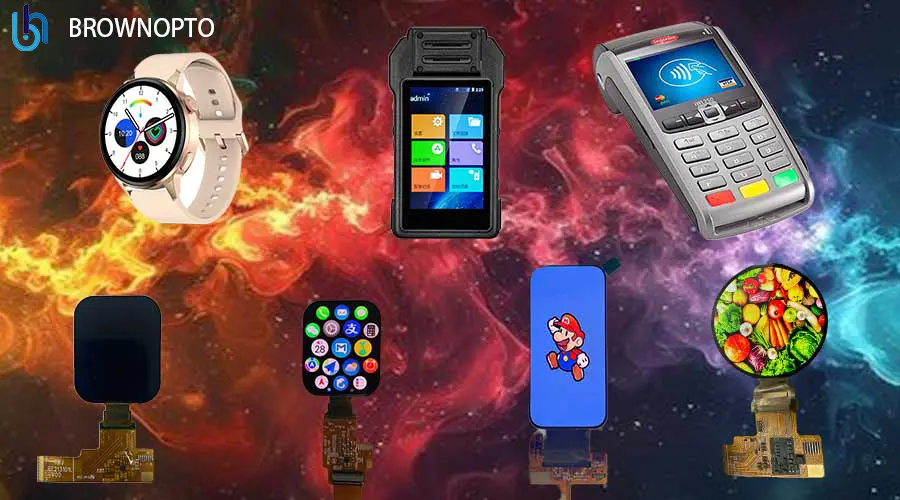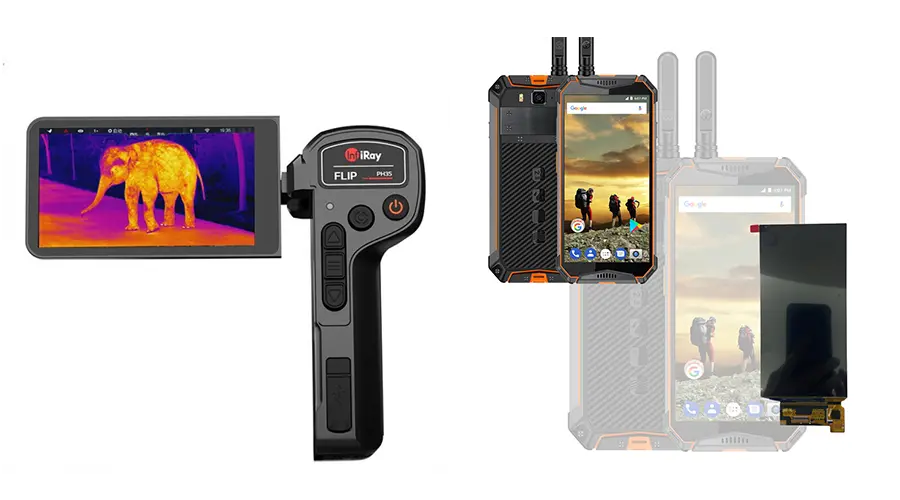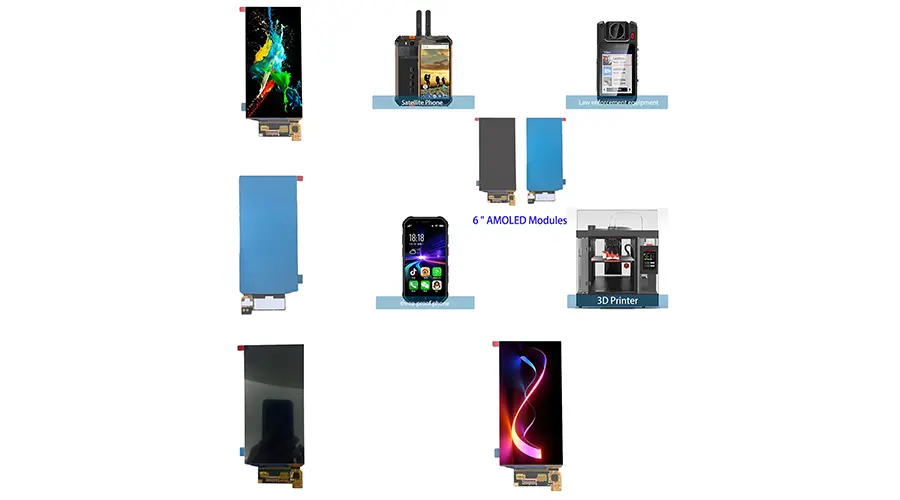A BROWNOPTO Engineering Case Study with MedTech Innovations Inc.
Kunde: MedTech Innovations Inc. — a U.S.-based innovator in point-of-care (POC) diagnostic systems
Application: Portable Blood Chemistry Analyzer for Emergency & Rural Healthcare
BROWNOPTO Product: Custom 4.40" On-Cell Touch LTPS AMOLED Display Module (Model: BR440102-A1)
Schnittstelle: MIPI DSI 2-lane, 60Hz refresh rate
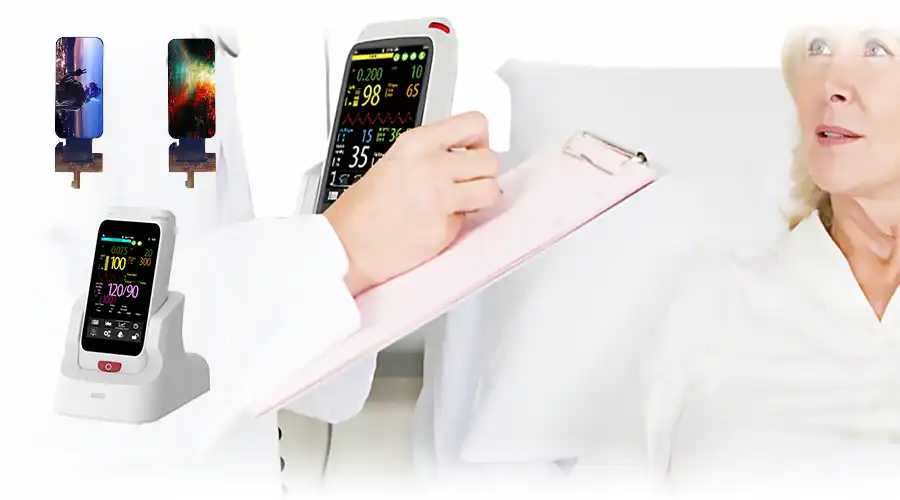
Project Background & Technical Challenges
MedTech Innovations sought to replace the legacy LCD in its flagship handheld blood analyzer with a next-generation display that could meet the stringent demands of clinical and field environments. The device is used by paramedics, lab technicians, and rural health workers—often in uncontrolled lighting, temperature, and humidity conditions.
The core display requirements included:
Sunlight readability: Minimum 600 nits brightness with anti-reflective (AR) treatment to ensure legibility under direct sunlight (≥100,000 lux).
Umweltrobustheit:Stabiler Betrieb bei Umgebungstemperaturen von -20 °C bis +70 °C und 95 % relativer Luftfeuchtigkeit (nicht kondensierend).
Menschliche Faktoren:Handschuhkompatible kapazitive Touch-Technologie mit Nassfingererkennung und geringer Latenz (<20 ms).
Formfaktor:Moduldicke ≤0,8 mm für ein schlankeres, ergonomischeres Handheld-Gehäuse.
Einhaltung gesetzlicher Vorschriften:Vollständige Einhaltung der RoHS 2.0 (2015/863/EU), REACH (SVHC < 0,1%) und der halogenfreien (HF) Materialnormen für medizinische Geräte.
Langfristige Zuverlässigkeit:Mehr als 50.000 Betriebsstunden bei minimalem Helligkeitsverlust.
Handelsübliche AMOLED-Panels erfüllten nicht die für Medizinprodukte der Klasse II erforderlichen Anforderungen an mechanische Belastbarkeit und optische Konsistenz. Die Medizintechnikbranche benötigte einen Displaypartner, der zur gemeinsamen Entwicklung – und nicht nur zur Lieferung – fähig war.
Gemeinsam entwickelte AMOLED-Displaylösung von BROWNOPTO
BROWNOPTO führte ein sechsmonatiges gemeinsames Entwicklungsprogramm mit den Hardware- und Firmware-Teams von MedTech durch. Die Zusammenarbeit umfasste optisches Design, mechanische Integration, elektrische Validierung und die Erstellung der regulatorischen Dokumentation.
Zu den wichtigsten Meilensteinen im Engineering-Bereich gehörten:
Optimierung des optischen Stapels:Integration eines hybriden HC (Hard Coat) + AR-Polarisators zur Reduzierung der Oberflächenreflexion auf <1,5% bei gleichzeitiger Aufrechterhaltung der Kratzfestigkeit (≥3H Bleistifthärte).
On-Cell-Touch-Integration:Individuelle Anpassung der Firmware des CST3530-Touch-Controllers zur Unterstützung der Eingabe mit 5 mm breiten Handschuhen und zur Vermeidung von Fehlauslösungen durch Feuchtigkeit oder Handflächenkontakt.
Wärmemanagement:Einsatz einer flexiblen Leiterplatte (FPC) mit geringer Wärmeausdehnung zur Vermeidung von Delaminationen bei Temperaturwechselbeanspruchung.
Leistungssequenzierung:Gemeinsame Entwicklung der Ein-/Ausschaltzeiten des Displays mit dem PMIC von MedTech zur Vermeidung von Bildschirmflimmern beim Hochfahren.
Farbkalibrierung:Werkseitig durchgeführte Gamma- und Weißpunktkalibrierung (D65, 2,2 Gamma) zur Gewährleistung einer genauen Darstellung medizinischer UI-Elemente (z. B. Warnsymbole, Trenddiagramme).
Technische Spezifikationen
| Parameter | Spezifikation | Validierungsstandard |
|---|---|---|
| Anzeigetyp | 4,40" LTPS AMOLED | — |
| Aktiver Bereich | 54,3 × 115,8 mm | — |
| Auflösung | 568 × 1210 Pixel (Full HD+) | Pixeldichte: 296 PPI |
| Helligkeit | 600 Nits (typisch), 800 Nits (Spitzenwert) | Gemessen nach ISO 13406-2 |
| Kontrastverhältnis | 100.000:1 (typisch) | Unendlich unter dunklen Bedingungen |
| Touch-Technologie | On-Cell-kapazitiv (CST3530 IC) | Unterstützt 10-Punkt-Multitouch |
| Betrachtungswinkel | ≥85° (in alle Richtungen) | ΔE < 5 bei 80° |
| Moduldicke | 0,75 mm (ohne FPC) | — |
| Schnittstelle | MIPI DSI 2-spurig, 60 Hz | Konform mit MIPI Alliance v1.3 |
| Betriebstemperatur. | -20°C bis +70°C | IEC 60068-2-1 / -2-2 |
| Lagertemperatur. | -30 °C bis +80 °C | — |
| Einhaltung | RoHS 2.0, REACH, HF, ISO 10993-5 (Zytotoxizitätstest) | Vollständige Materialdeklaration verfügbar |
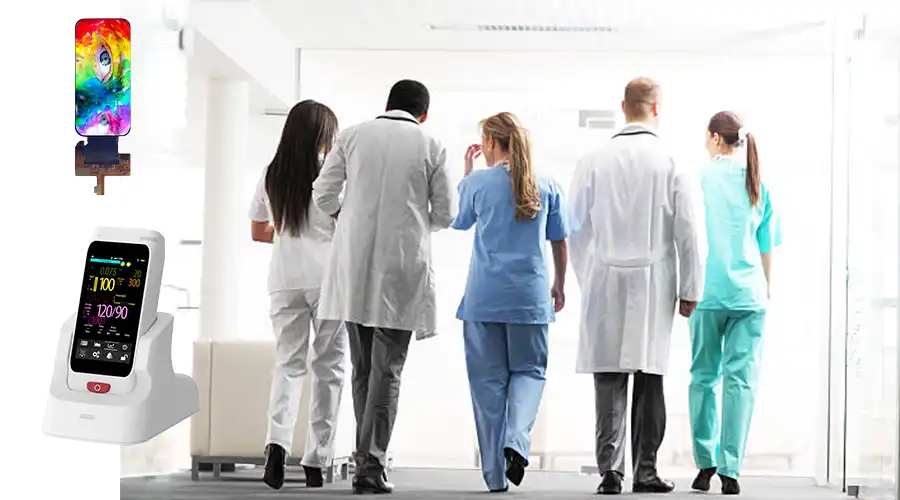
Validation & Field Performance
Das Modul BR440102-A1 wurde sowohl in den Einrichtungen von BROWNOPTO als auch von MedTech einer strengen Validierung unterzogen:
Umweltprüfung:Überstanden 240 Stunden Hoch-/Tieftemperaturzyklen (-20 °C ↔ +70 °C) und 96 Stunden Exposition bei 95 % relativer Luftfeuchtigkeit ohne Delamination oder Mura.
Mechanische Robustheit:Überstand 3 Stürze aus 1,2 m Höhe auf Sperrholz (gemäß IEC 60601-1-11) ohne Funktionsstörung.
Optische Konsistenz:Leuchtdichtegleichmäßigkeit >85 % über die gesamte Fläche; Farbverschiebung (Δu'v') < 0,01 bei Variation des Betrachtungswinkels.
Klinische Pilotstudie:Im Einsatz in 500 Einheiten bei 12 US-amerikanischen Rettungsdiensten (EMS) über einen Zeitraum von 12 Monaten – keine Ausfälle im Zusammenhang mit dem Display wurden gemeldet.
„BROWNOPTO hat uns nicht einfach nur ein Display geliefert – sie haben sich aktiv in unseren Produktentwicklungsprozess eingebracht. Ihr Ingenieurteam hat die Probleme mit dem Touch-Geräusch gelöst, mit denen wir monatelang zu kämpfen hatten, und sichergestellt, dass das AMOLED-Display die FDA-Dokumentationsanforderungen hinsichtlich der Materialrückverfolgbarkeit erfüllt. Diese Partnerschaft war maßgeblich für unsere Produkteinführung.“
— Leitender Hardware-Systemingenieur, MedTech Innovations Inc.
Warum BROWNOPTO AMOLED-Displays in medizinischen Anwendungen hervorragend geeignet sind
Der Ansatz von BROWNOPTO geht über die Komponentenlieferung hinaus. Wir bieten umfassende Displayentwicklung für unternehmenskritische Anwendungen:
Anwendungsorientiertes Design:Displays, die für den realen Einsatz entwickelt wurden – nicht nur für die Spezifikationen im Datenblatt.
Vertikale Integration:Eigene optische Beschichtung, Touch-Integration und Zuverlässigkeitsprüfung.
Regulatorische Unterstützung:Vollständige Dokumentation zur Materialkonformität (RoHS, REACH, HF, ISO 10993) für die Zulassung von Medizinprodukten.
Skalierbares NPI:Vom Prototyp bis zur Serienproduktion mit gleichbleibender Qualität (PPM < 50).
Weltweite Unterstützung:Ingenieurteams in Asien, Nordamerika und Europa für schnelle Reaktionszeiten.
Sind Sie bereit, ein hochzuverlässiges AMOLED-Display in Ihr medizinisches, industrielles oder Verteidigungsgerät zu integrieren?
Kontaktieren Sie BROWNOPTOFür eine individuelle Displayberatung – entwickelt für Leistung, gebaut für Zuverlässigkeit.
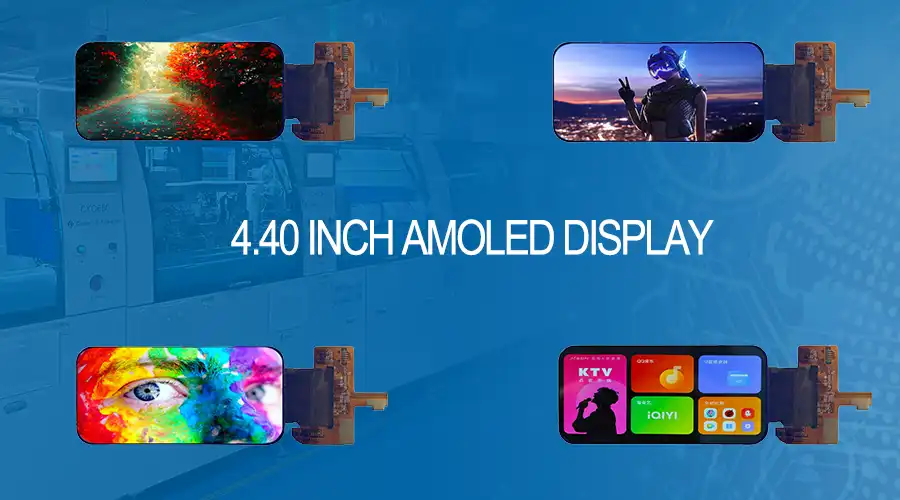
Häufig gestellte Fragen
Was verursacht das Einbrennen von OLEDs und wie kann es verhindert werden?
Einbrennen tritt auf, wenn organische Materialien durch die längere Anzeige statischer Bilder ungleichmäßig abgenutzt werden. Zur Vorbeugung können Sie automatisches Dimmen, Bildschirm-Timeout, Pixelverschiebung, Logo-Dimmen und die Vermeidung hoher Helligkeiten bei statischen Inhalten verwenden.
Sind OLED-Displays für den Außenbereich oder Umgebungen mit hoher Helligkeit geeignet?
Standard-OLEDs haben aufgrund ihrer begrenzten Spitzenhelligkeit Probleme mit direkter Sonneneinstrahlung. Einige Modelle verfügen jedoch über eine höhere Nits-Leistung und Antireflexbeschichtungen. Für den Einsatz im Freien eignen sich Mini-LEDs oder spezielle OLED-Varianten mit hoher Helligkeit.
Wie lange halten OLED-Displays normalerweise?
Die Lebensdauer von OLEDs beträgt typischerweise 30.000 bis 100.000 Stunden bei L50 (halbe Helligkeit). Die Lebensdauer hängt von Nutzungsmustern, Helligkeitsstufen und Betriebstemperatur ab. Blaue Pixel altern schneller, daher kann sich der Weißabgleich mit der Zeit verschieben.
Können OLEDs für Always-On-Displays (AOD) verwendet werden?
Ja – OLEDs eignen sich aufgrund ihres geringen Stromverbrauchs bei der Anzeige dunkler Designs oder kleiner Symbole ideal für AOD. Um das Einbrennen zu reduzieren, sollten Sie dynamische Positionierung, geringe Helligkeit und eine begrenzte Anzahl aktiver Pixel verwenden.
Was ist der Unterschied zwischen AMOLED und PMOLED?
AMOLED (Active Matrix OLED) verwendet eine TFT-Backplane für schnelle Aktualisierung und hohe Auflösungen – ideal für Smartphones und Wearables. PMOLED (Passive Matrix OLED) steuert Zeilen/Spalten direkt an und eignet sich für kleinere, einfachere und kostengünstigere Displays.
Unterstützen OLED-Displays die Touch-Funktionalität?
Ja – die meisten OLED-Module verfügen über kapazitive (PCAP) oder resistive Touch-Schichten. Flexible OLEDs werden oft mit gebogenen Touch-Sensoren kombiniert, um nahtlose Designs für Wearables und Automobile zu ermöglichen.
Neueste Artikel
-
Warum 1–2"-AMOLEDs im Jahr 2025 der Schlüssel zu AR/XR sind
Warum 1–2 Zoll große AMOLED-Displays im Zuge des AR/XR-Booms unverzichtbar werden (Brancheneinblicke 2025)
-
Understanding OLED Display Technology: Principles, Performance & Applications
OLED (Organic Light Emitting Diode) displays are a class of self-emissive display technology in whic
-
From Wearables to AR Glasses – How OLED Displays Are Redefining Visual Experiences in 2025
By 2025, OLED (Organic Light-Emitting Diode) technology has transitioned from luxury smartphone disp
-
Stretched Bar LCD Displays for Retail: Boost Sales & Engagement in Supermarkets
Discover how stretched bar LCD displays enhance supermarket shelf-edge marketing, drive sales, reduc
-
Stretched LCD Solutions for Restaurants and Hospitality Venues
Gestreckte LCDs bieten schlanke, hochhelle Displays, die sich perfekt für Restaurantmenüs und Gastronomie-Si eignen

